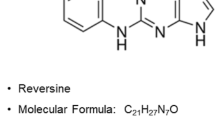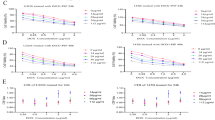Abstract
Despite the advances of adjuvant chemotherapy and significant improvement of survival, the prognosis for patients with osteosarcoma is generally poor. The search for more effective anti-osteosarcoma agents is necessary and urgent. Here we report that perifosine induces cell apoptosis and growth inhibition in cultured human osteosarcoma cells. Perifosine blocks Akt/mTOR complex 1 (mTORC1) signaling, while promoting caspase-3, c-Jun N-terminal kinases (JNK), and p53 activation. Further, perifosine inhibits survivin expression probably by disrupting its association with heat shock protein-90 (HSP-90). These signaling changes together were responsible for a marked increase of osteosarcoma cell apoptosis and growth inhibition. Finally, we found that a low dose of perifosine enhanced etoposide- or doxorubicin-induced anti-OS cells activity. The results together suggest that perifosine might be used as a novel and effective anti-osteosarcoma agent.







Similar content being viewed by others
Abbreviations
- mTORC1:
-
mTOR complex 1
- JNK:
-
c-Jun N-terminal kinases
- ERK:
-
Extracellular signal-regulated kinase
- MTT:
-
3-[4,5-dimethylthylthiazol-2-yl]-2,5 diphenyltetrazolium bromide
- HSP-90:
-
Heat shock protein-90
- PBS:
-
Phosphate-buffered saline
- ROS:
-
Reactive oxygen species
- HDACi:
-
Histone deacetylase inhibitor
- PI3K:
-
Phosphoinositide 3-kinase
References
Ham, S. J., Schraffordt Koops, H., van der Graaf, W. T., van Horn, J. R., Postma, L., & Hoekstra, H. J. (1998). Historical, current and future aspects of osteosarcoma treatment. European Journal of Surgical Oncology, 24, 584–600.
Rosen, G., Marcove, R. C., Caparros, B., Nirenberg, A., Kosloff, C., & Huvos, A. G. (1979). Primary osteogenic sarcoma: The rationale for preoperative chemotherapy and delayed surgery. Cancer, 43, 2163–2177.
Kondapaka, S. B., Singh, S. S., Dasmahapatra, G. P., Sausville, E. A., & Roy, K. K. (2003). Perifosine, a novel alkylphospholipid, inhibits protein kinase B activation. Molecular Cancer Therapeutics, 2, 1093–1103.
Ruiter, G. A., Zerp, S. F., Bartelink, H., van Blitterswijk, W. J., & Verheij, M. (1999). Alkyl-lysophospholipids activate the SAPK/JNK pathway and enhance radiation-induced apoptosis. Cancer Research, 59, 2457–2463.
Cirstea, D., Hideshima, T., Rodig, S., Santo, L., Pozzi, S., Vallet, S., et al. (2011). Dual inhibition of akt/mammalian target of rapamycin pathway by nanoparticle albumin-bound-rapamycin and perifosine induces antitumor activity in multiple myeloma. Molecular Cancer Therapeutics, 9, 963–975.
Crul, M., Rosing, H., de Klerk, G. J., Dubbelman, R., Traiser, M., Reichert, S., et al. (2002). Phase I and pharmacological study of daily oral administration of perifosine (D-21266) in patients with advanced solid tumours. European Journal of Cancer, 38, 1615–1621.
Van Ummersen, L., Binger, K., Volkman, J., Marnocha, R., Tutsch, K., Kolesar, J., et al. (2004). A phase I trial of perifosine (NSC 639966) on a loading dose/maintenance dose schedule in patients with advanced cancer. Clinical Cancer Research, 10, 7450–7456.
Fei, H. R., Chen, G., Wang, J. M., & Wang, F. Z. (2010). Perifosine induces cell cycle arrest and apoptosis in human hepatocellular carcinoma cell lines by blockade of Akt phosphorylation. Cytotechnology, 62, 449–460.
Papa, V., Tazzari, P. L., Chiarini, F., Cappellini, A., Ricci, F., Billi, A. M., et al. (2008). Proapoptotic activity and chemosensitizing effect of the novel Akt inhibitor perifosine in acute myelogenous leukemia cells. Leukemia, 22, 147–160.
Chiarini, F., Del Sole, M., Mongiorgi, S., Gaboardi, G. C., Cappellini, A., Mantovani, I., et al. (2008). The novel Akt inhibitor, perifosine, induces caspase-dependent apoptosis and downregulates P-glycoprotein expression in multidrug-resistant human T-acute leukemia cells by a JNK-dependent mechanism. Leukemia, 22, 1106–1116.
Sun, H., Yu, T., & Li, J. (2011). Co-administration of perifosine with paclitaxel synergistically induces apoptosis in ovarian cancer cells: More than just AKT inhibition. Cancer Letters, 310, 118–128.
Kumar, A., Fillmore, H. L., Kadian, R., Broaddus, W. C., Tye, G. W., & Van Meter, T. E. (2009). The alkylphospholipid perifosine induces apoptosis and p21-mediated cell cycle arrest in medulloblastoma. Molecular Cancer Research, 7, 1813–1821.
Rahmani, M., Reese, E., Dai, Y., Bauer, C., Payne, S. G., Dent, P., et al. (2005). Coadministration of histone deacetylase inhibitors and perifosine synergistically induces apoptosis in human leukemia cells through Akt and ERK1/2 inactivation and the generation of ceramide and reactive oxygen species. Cancer Research, 65, 2422–2432.
Paoloni, M. C., Mazcko, C., Fox, E., Fan, T., Lana, S., Kisseberth, W., et al. (2011). Rapamycin pharmacokinetic and pharmacodynamic relationships in osteosarcoma: A comparative oncology study in dogs. PLoS ONE, 5, e11013.
Zhang, B., Shi, Z. L., Liu, B., Yan, X. B., Feng, J., & Tao, H. M. (2010). Enhanced anticancer effect of gemcitabine by genistein in osteosarcoma: The role of Akt and nuclear factor-kappaB. Anti-Cancer Drugs, 21, 288–296.
Zhou, R., Zhang, Z., Zhao, L., Jia, C., Xu, S., Mai, Q., et al. (2010). Inhibition of mTOR signaling by oleanolic acid contributes to its anti-tumor activity in osteosarcoma cells. Journal of Orthopaedic Research, 29, 846–852.
Jin, S., Pang, R. P., Shen, J. N., Huang, G., Wang, J., & Zhou, J. G. (2007). Grifolin induces apoptosis via inhibition of PI3K/AKT signalling pathway in human osteosarcoma cells. Apoptosis, 12, 1317–1326.
Hideshima, T., Catley, L., Yasui, H., Ishitsuka, K., Raje, N., Mitsiades, C., et al. (2006). Perifosine, an oral bioactive novel alkylphospholipid, inhibits Akt and induces in vitro and in vivo cytotoxicity in human multiple myeloma cells. Blood, 107, 4053–4062.
Altieri, D. C. (2003). Survivin, versatile modulation of cell division and apoptosis in cancer. Oncogene, 22, 8581–8589.
Altieri, D. C., & Marchisio, P. C. (1999). Survivin apoptosis: An interloper between cell death and cell proliferation in cancer. Laboratory Investigation, 79, 1327–1333.
Altieri, D. C. (2003). Validating survivin as a cancer therapeutic target. Nature Reviews Cancer, 3, 46–54.
Trieb, K., Lehner, R., Stulnig, T., Sulzbacher, I., & Shroyer, K. R. (2003). Survivin expression in human osteosarcoma is a marker for survival. European Journal of Surgical Oncology, 29, 379–382.
Wu, Y. F., Liang, X. J., Liu, Y. Y., Gong, W., Liu, J. X., Wang, X. P., et al. (2010). +Antisense oligonucleotide targeting survivin inhibits growth by inducing apoptosis in human osteosarcoma cells MG-63. Neoplasma, 57, 501–506.
Zhang, H. Z., Wang, Y., Gao, P., Lin, F., Liu, L., Yu, B., et al. (2006). Silencing stathmin gene expression by survivin promoter-driven siRNA vector to reverse malignant phenotype of tumor cells. Cancer Biology & Therapy, 5, 1457–1461.
Zou, J., Gan, M., Mao, N., Zhu, X., Shi, Q., & Yang, H. (2010). Sensitization of osteosarcoma cell line SaOS-2 to chemotherapy by downregulating survivin. Archives of Medical Research, 41, 162–169.
Fortugno, P., Beltrami, E., Plescia, J., Fontana, J., Pradhan, D., Marchisio, P. C., et al. (2003). Regulation of survivin function by Hsp90. Proceedings of the National Academy of Sciences of the United States of America, 100, 13791–13796.
Merrill, A. H., Jr, van Echten, G., Wang, E., & Sandhoff, K. (1993). Fumonisin B1 inhibits sphingosine (sphinganine) N-acyltransferase and de novo sphingolipid biosynthesis in cultured neurons in situ. Journal of Biological Chemistry, 268, 27299–27306.
Charles, A. G., Han, T. Y., Liu, Y. Y., Hansen, N., Giuliano, A. E., & Cabot, M. C. (2001). Taxol-induced ceramide generation and apoptosis in human breast cancer cells. Cancer Chemotherapy and Pharmacology, 47, 444–450.
Vinall, R. L., Hwa, K., Ghosh, P., Pan, C. X., Lara, P. N., Jr, & de Vere White, R. W. (2007). Combination treatment of prostate cancer cell lines with bioactive soy isoflavones and perifosine causes increased growth arrest and/or apoptosis. Clinical Cancer Research, 13, 6204–6216.
Ruiter, G. A., Verheij, M., Zerp, S. F., & van Blitterswijk, W. J. (2001). Alkyl-lysophospholipids as anticancer agents and enhancers of radiation-induced apoptosis. International Journal of Radiation Oncology Biology Physics, 49, 415–419.
Vivanco, I., & Sawyers, C. L. (2002). The phosphatidylinositol 3-Kinase AKT pathway in human cancer. Nature Reviews Cancer, 2, 489–501.
Hennessy, B. T., Smith, D. L., Ram, P. T., Lu, Y., & Mills, G. B. (2005). Exploiting the PI3K/AKT pathway for cancer drug discovery. Nature Reviews Drug Discovery, 4, 988–1004.
Garcia-Echeverria, C., & Sellers, W. R. (2008). Drug discovery approaches targeting the PI3K/Akt pathway in cancer. Oncogene, 27, 5511–5526.
LoPiccolo, J., Granville, C. A., Gills, J. J., & Dennis, P. A. (2007). Targeting Akt in cancer therapy. Anti-Cancer Drugs, 18, 861–874.
Lu, Y., Wang, H., & Mills, G. B. (2003). Targeting PI3K-AKT pathway for cancer therapy. Reviews in Clinical & Experimental Hematology, 7, 205–228.
Gills, J. J., & Dennis, P. A. (2009). Perifosine: Update on a novel Akt inhibitor. Current Oncology Reports, 11, 102–110.
Hennessy, B. T., Lu, Y., Poradosu, E., Yu, Q., Yu, S., Hall, H., et al. (2007). Pharmacodynamic markers of perifosine efficacy. Clinical Cancer Research, 13, 7421–7431.
Wang, Q., Wang, X., Hernandez, A., Hellmich, M. R., Gatalica, Z., & Evers, B. M. (2002). Regulation of TRAIL expression by the phosphatidylinositol 3-kinase/Akt/GSK-3 pathway in human colon cancer cells. Journal of Biological Chemistry, 277, 36602–36610.
Tazzari, P. L., Tabellini, G., Ricci, F., Papa, V., Bortul, R., Chiarini, F., et al. (2008). Synergistic proapoptotic activity of recombinant TRAIL plus the Akt inhibitor Perifosine in acute myelogenous leukemia cells. Cancer Research, 68, 9394–9403.
Simbulan-Rosenthal, C. M., Rosenthal, D. S., Luo, R., & Smulson, M. E. (1999). Poly(ADP-ribosyl)ation of p53 during apoptosis in human osteosarcoma cells. Cancer Research, 59, 2190–2194.
Schuler, M., Bossy-Wetzel, E., Goldstein, J. C., Fitzgerald, P., & Green, D. R. (2000). p53 induces apoptosis by caspase activation through mitochondrial cytochrome c release. Journal of Biological Chemistry, 275, 7337–7342.
Workman, P., & Powers, M. V. (2007). Chaperoning cell death: A critical dual role for Hsp90 in small-cell lung cancer. Nature Chemical Biology, 3, 455–457.
Whitesell, L., & Lindquist, S. L. (2005). HSP90 and the chaperoning of cancer. Nature Reviews Cancer, 5, 761–772.
Neckers, L. (2002). Hsp90 inhibitors as novel cancer chemotherapeutic agents. Trends in Molecular Medicine, 8, S55–61.
Conflict of interest
The authors declare no conflict of interests.
Author information
Authors and Affiliations
Corresponding author
Electronic supplementary material
Below is the link to the electronic supplementary material.
Fig. S1
Perifosine inhibits Akt phosphorylation in cultured osteosarcoma cells. U2OS, SaOs-2 and MG-63 osteosarcoma cells were treated with indicated concentration of perifosine for 12 h, p-Akt (Ser 473) and Akt1 were examined by Western blot (EPS 814 kb)
Rights and permissions
About this article
Cite this article
Yao, C., Wei, Jj., Wang, Zy. et al. Perifosine Induces Cell Apoptosis in Human Osteosarcoma Cells: New Implication for Osteosarcoma Therapy?. Cell Biochem Biophys 65, 217–227 (2013). https://doi.org/10.1007/s12013-012-9423-5
Published:
Issue Date:
DOI: https://doi.org/10.1007/s12013-012-9423-5




